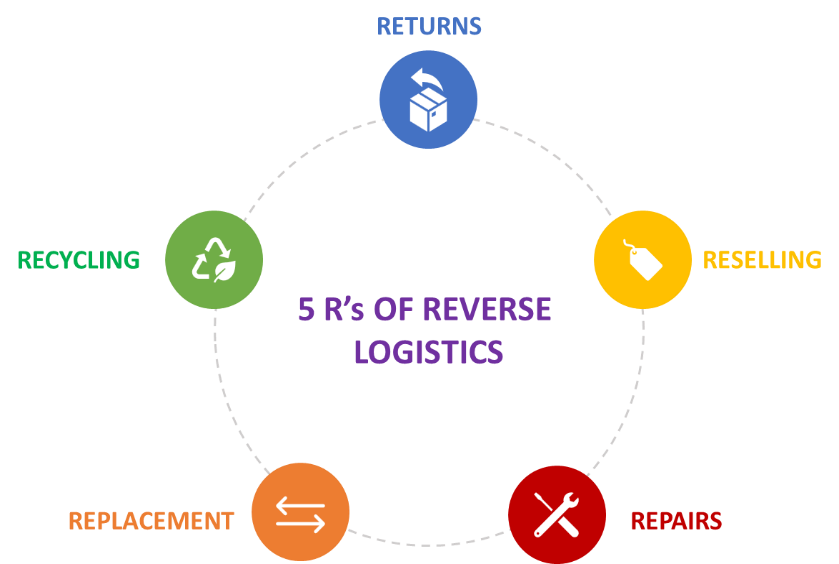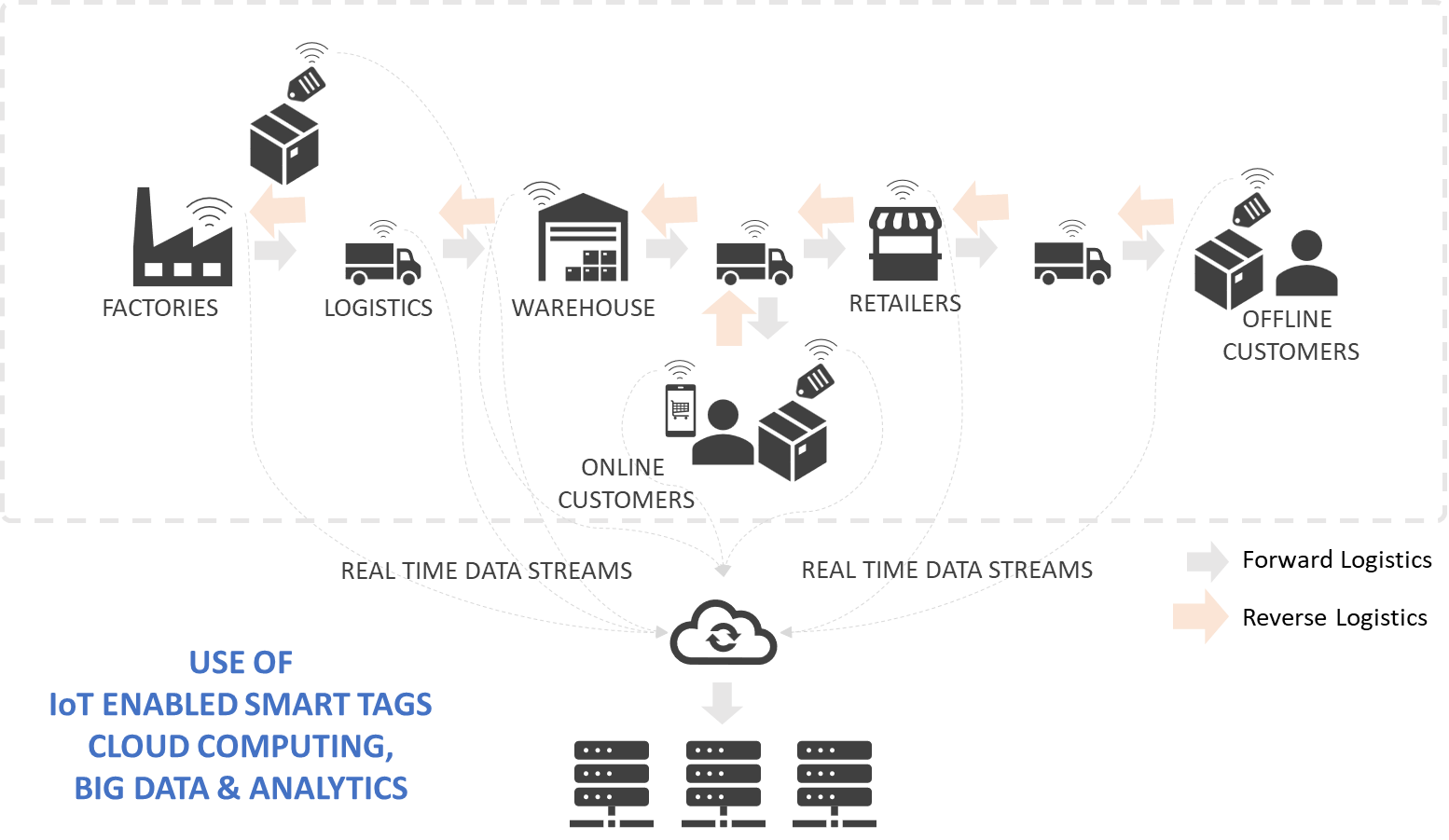Industry 4.0 & Reverse Logistics: It’s Time For Transformation
By Gaurav Upmanyu, Adtech Corp
For years, reverse logistics has survived in the shadows of the traditional forward-looking supply chain. However, the trend is changing faster than ever due to increasing demands from various stakeholders – customers, regulatory authorities, and investors. Growing competition and accelerated eCommerce adoption further act as catalysts. In this article, we’ll determine if the emergence of Industry 4.0 technologies makes it possible for companies to establish an efficient and cost-effective closed-loop supply chain through enhanced reverse logistics.
NEW KID ON THE BLOCK
For a very long time, reverse logistics has been a not-so-innovative or looked-upon part of the supply chain discipline. This was mainly because it was (and still is) an extremely complex and costly affair. For reverse logistics to be successful, extensive tracking is required at every step. Furthermore, organizations need to set up the right infrastructure to make the flow bi-directional and effective while managing profitability. However, with the onset of Industry 4.0, reverse logistics is finally receiving the proper attention it deserves.
BREAKING DOWN REVERSE LOGISTICS
Reverse logistics is typically defined as the process of goods traveling from the end customer back to the manufacturer or retailer.

Figure 1: 5r’s of reverse logistics
More comprehensively, it can be broken down into the famous 5 R’s:
- Returns & Exchanges: While returns and exchanges are the strength of bigger players, it is a hassle for the smaller ones - mainly because of resource constraints and a lack of volume discounts. The onset of eCommerce has further exacerbated the difficulty of returns as 10% of in-store purchases and a jaw-dropping 30% of online purchases are returned.
- Reselling Returned Products: A recent study revealed that the market for returned products is worth over $15 Billion annually in the US alone. It’s important to note that 95% of these products are returned not due to any fault or error of the manufacturer or retailer, but purely because of the personal choices of end customers (and hence can be easily resold).
- Repairs: A company can boost its revenue by repairing defective or damaged goods, which can then be either returned to the original owner or sold to a new customer as a refurbished product. Often, customers prefer to get their items repaired rather than pay more money for a new product. Furthermore, some customers don’t mind receiving a discount for products that look and operate as new.
- Replacements: Customers may sometimes request replacements due to size issues or color preferences. Providing quick and easy replacements results in increased customer loyalty. Conversely, cumbersome replacement policies and procedures can result in decreased customer satisfaction and subsequently customer loyalty.
- Recycling & Disposal: Recycling and Disposal are important not only due to regulatory compliance but also due to the growing popularity of sustainable businesses. While 50% of US states mandate recycling of electronic goods, 25% of customers prefer sustainable businesses. Recycling also leads to a substantial increase in profits, for example, Apple increased its profits by an estimated $40 million in 2015 alone by recycling.
THE ADVENT OF INDUSTRY 4.0
Though most of us have heard the term ‘Industry 4.0’, few are aware of the details. Let’s briefly review the history of industrial revolutions and Industry 4.0:
1st Industrial Revolution: It is considered to have begun in the late 18th century around England and marks the transition to steam energy.
2nd Industrial Revolution: It is considered to have begun in the late 19th century. It is associated with the introduction of not one but multiple changes, each with huge impacts. It brought in the transition from steam energy to electric energy and is also associated with the introduction of enhanced communication systems like the telephone, telegraph, and radio.
3rd Industrial Revolution: It’s believed to have occurred in the middle of the 20th century and it brought in computers and the internet, boosting communication and digitization.
4th Industrial Revolution: We are currently in the midst of the fourth Industrial Revolution or ‘Industry 4.0’ as it is popularly known. It is being propelled by technologies such as Internet of Things (IoT)1, Artificial Intelligence (AI)2, Machine Learning (ML)3, Natural Language Processing (NLP)4, Big Data and Analytics5, Augmented Reality (AR)6, Virtual Reality (VR)7, 3-Dimensional (3D) Printing8, Blockchain9, etc.
These technologies are bringing in multifold improvements in productivity, automation, and data-based prediction, enabling sustainable development without negatively impacting profits. Studies and research by McKinsey and World Economic Forum state that these technologies are expected to create a positive impact of up to $3.7 Trillion in value on the global economy by 2025.

Figure 2: History of Industrial Revolutions
HOW CAN INDUSTRY 4.0 IMPACT REVERSE LOGISTICS
Along the lines of IoT, the use of Smart Tags can ensure that every item is grouped in the correct shipment. Smart Tags can also ensure that items are delivered to the right address and within the promised timelines. The proper grouping of shipments can also ensure that items are not damaged or unusable when reaching end customers, especially in the case of fragile or perishable items. If needed, smart tags can also help track the shipping and storage conditions to further ensure the quality of the items.
Aside from IoT, Big Data and Analytics can help maintain optimal distribution and inventory levels across different warehouses. This helps in the delivery of items at the right time and at minimal shipping costs.
Robotics, AR, and AI can enhance the movement of items across the supply chain with optimal speed and accuracy. The usage of these technologies also reduces the probability of damaged or delayed shipments.

Figure 3: Use of IoT-enabled Smart Tags, Cloud Computing, Big Data, and Analytics Across Supply Chain
Furthermore, AR technology can benefit end customers as well. For example, AR can enable prospective customers to experience products before buying them. This is especially helpful when it comes to the fit, and color of the apparel. The net impact is reduced product replacements and returns, which benefits both customers and companies alike. Though companies are advised to have a robust reverse logistics process to create a sustainable closed supply chain (as discussed above) and loyal customers, it is beneficial to reduce reversals caused by other reasons.
RETURNS, EXCHANGES, AND REPLACEMENTS
The use of IoT Smart Tags helps in the identification and validation of the item requested for return through quick information exchange. This in turn would help minimize cycle times, resulting in greater customer satisfaction. It would not only minimize overhead costs of storing the item, but especially items that are perishable, and which may run out of fashion while being stuck in the supply chain. It also minimizes the risk of the item getting lost somewhere in the warehouse.
The use of Big Data and Analytics would help optimize the cycle time by making more accurate predictions, and identifying the correct warehouse based on multiple factors like minimal time to get back to the mainstream, warehouse capacity, etc.
There have been cases reported in India where people have duped Indian eCommerce giants of millions of dollars before being caught. The use of Blockchain could enable quick and accurate validation of the returned item and such situations could be avoided altogether.
Robots can also be utilized to automate (partially or completely) the process of getting the returned items back in the supply chain. A lot of companies are already experimenting with the usage of drones and robots to move items within and between warehouses.
It would be a good idea to invest in these technologies as research has found that almost 50% of hi-tech customers would return a purchased item, however, the good news is that almost 50% of these customers would make a new purchase as well.
RESELLING RETURNED PRODUCTS
smart Tags can help us validate items before being resold, based on factors like jerks/drops for fragile items, storage conditions, and expiration for perishable items. Smart Tags can also help in streamlining the sale of returned products through real-time tracking very much like a regular forward-looking supply chain.
ML along with Big Data and Analytics can help us determine the right price at which returned items can be resold. This would help in increasing customer interest in returned products, resulting in cost benefits through fast-moving inventory.
A combination of smart tags, ML, and Big Data and Analytics can help us identify the right warehouses to send the returned item to so that the reshipping cost and time can be optimized. It would be specifically important for items that need specific storage conditions like cold storage etc.
REPAIRS
Smart Tags can help us with repairs as well, in identifying if and what repair is needed for an item based on multiple factors. We can also look at the types and frequency of repairs to evaluate if robotics and automation can be leveraged. This would be great for cases where repairs involve repetitive activities which don’t change or vary a lot.
AR and VR can be utilized for training and assessment of the manual workforce before onboarding. We can also look at a scenario where an on-the-job employee can be guided by a more experienced expert, virtually through the use of a real-time augmented reality platform. This would increase the efficiency and accuracy of repairs.
A combination of Smart Tags, ML, Big Data, and Analytics can help us identify the right warehouses to support the repair capabilities and the right repair capabilities for each such warehouse. This would help us increase savings by optimizing the spending on such capabilities.
These technologies can also help us predict whether scraping or repairing would be a more cost-effective measure for a specific item. It is important to note that studies have shown that 25% of all incoming/returned products can be quickly resold after repairs.
RECYCLING AND DISPOSAL
Though 84% of people globally consider recycling to be extremely important, the global recycling rate is as low as only 19%. The biggest roadblock is that recycling is still a costly affair, while other reasons include the absence of a cost-effective reverse logistics process, cumbersome segregation process, and lack of expertise to recycle different types of materials. We have already discussed how reverse logistics can be improved by Industry 4.0 tech, let us see other benefits it can bring in.
- Use of Image Recognition powered by AI, ML, and Big Data can help in automating waste segregation with reduced cost and increased speed.
- Automated waste segregation would have to be accompanied by a strong workforce. They can be trained with the use of AR and VR as discussed in the article already.
- Creating recycling units everywhere and with expertise wouldn’t be cost-effective. Hence big data and analytics can be used to identify the locations and distribution of these recycling centers. These technologies would also help in identifying the expertise which each of these recycling units should possess.

SUMMARY
More than 33% of online buyers find returning products very difficult. This reduces customer satisfaction and is likely to reduce repeat purchases. And since acquiring a new customer is five times costlier than retaining an old customer, it is important to invest in reverse logistics. The current estimated value of returns across the globe – $1 trillion dollars annually - further emphasizes the relevance of reverse logistics. Reverse Logistics also helps to create a closed-loop supply chain, which helps not only to preserve our planet but also creates a clean and sustainable image for the company. Therefore, optimizing reverse logistics has the ability to attract more customers and investors alike. Finally, effective reverse logistics also helps companies stay compliant with certain local environmental regulations. With the emergence of new Industry 4.0 technologies, creating a robust, efficient, and cost-effective reverse logistics ecosystem has become easier than before.
GLOSSARY
1. Internet of Things (IoT): Any device or machine which consists of a sensor, making it possible to digitally connect with other internet enabled devices and exchange data.
2. Artificial Intelligence (AI): Intelligence represented by programs/machines which mimic humans’ ability of problem solving and rational thinking.
3. Machine Learning (ML): Ability of a machine/program to learn with its experiences, very similar to how humans do it.
4. Natural Language Processing (NLP): Ability of machines/programs to understand human language, i.e free speech.
5. Dig Data and Analytics: Collection, storage, and processing of large-scale data in different formats or types in order to make useful and accurate predictions about the near future trends.
6. Augmented Reality (AR): An amalgamation of digital and real environment.
7. Virtual Reality (VR): Simulation of a digital environment representing/mimicking a real environment.
8. 3-Dimentional (3D) Printing: Constructing a real 3-dimensional object based on a Digital 3-dimensional model.
9. Block Chain (BC): Blockchain is a shared, immutable ledger that facilitates the process of recording transactions and tracking assets in a business network.
REFERENCES
1. What is Industry 4.0? (purdue.edu)
2. What is Industry 4.0 and how does it work? | IBM
3. What is industry 4.0? | Definition, technologies, benefits | SAP Insights
4. What is Industry 4.0 | Oracle
5. What is Blockchain Technology? - IBM Blockchain | IBM
6. The 5 R’s of Reverse Logistics (forbes.com)
7. Managing the 5 R’s of Reverse Logistics (newcastlesys.com)
8. 2 students cheat Flipkart of Rs 1.05 crore, 152 premium phones - Technology News (indiatoday.in)
9. Recycling Challenges: What is stopping people from recycling more? (insightsartist.com)
 Gaurav Upmanyu
Gaurav UpmanyuGaurav leads the Project Management and QA vertical at Adtech Corp, a tech consultancy that helps small to large enterprises attain operational excellence. He is constantly involvedin brainstorming with leadership teams to identify key business goals and achieve them through the development and deployment of software tools. With nearly a decade of experience, Gaurav works out of the Silicon Valley of India and prior to Adtech created advanced approaches to development in the Digital Research & Development wing of Unilever.
www.adtechcorp.io